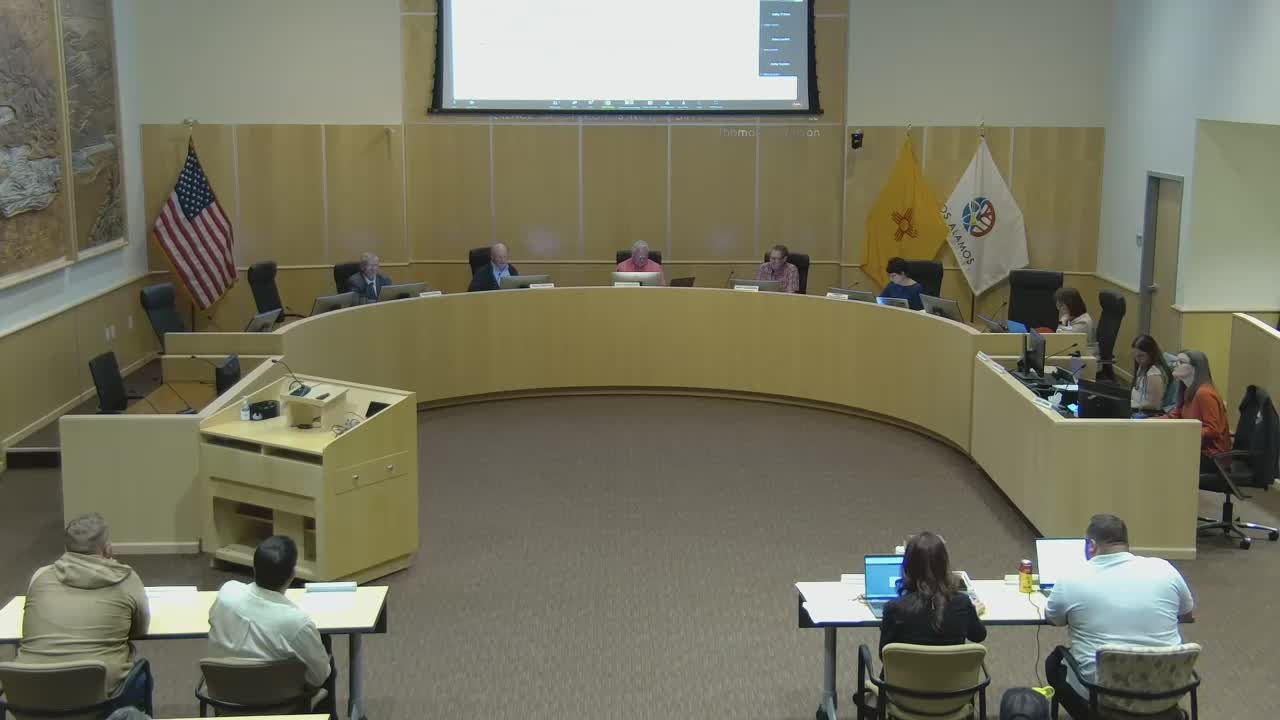Survey finds cost, efficiency and rebates shape electrification interest; 75% say they may need panel upgrades
November 05, 2025 | Los Alamos, New Mexico
This article was created by AI summarizing key points discussed. AI makes mistakes, so for full details and context, please refer to the video of the full meeting. Please report any errors so we can fix them. Report an error »

A consultant presenting survey results to the Los Alamos Department of Public Utilities board said the study, administered July through September 2025, collected about 912 responses with 582 complete and that respondents rated the survey "at least good" more than half the time. "So in this presentation, I'll go over the survey summary," the presenter said at the start of the briefing.
The respondent pool skewed older and wealthier than the community: the presenter gave an average respondent age of roughly 58, 64% male, 93% non-Hispanic, 86% reporting at least a bachelor's degree and a median household income "over $150,000 a year." Those demographics prompted several board members to question how representative the sample is of the full utility service area.
On appliance ownership, the study found 59% of households listed central furnaces as their primary space heat and that 90% of primary heating equipment is powered by natural gas. For cooking, 60% of households reported owning a range (combined oven and cooktop); among ranges and cooktops the majority run on natural gas, while independent wall ovens are predominantly electric.
The survey included a visual switching exercise and a discrete choice experiment (DCE) to measure trade-offs. The presenter summarized key DCE findings: for households that do not require a panel upgrade, an additional 10 percentage points of appliance efficiency was associated with roughly $19 to 21 in willingness to pay. Rebate levels had a larger effect on willingness to switch for households that do need panel upgrades. The presenter told the board, "75% of households do need an upgrade in their electric panel," and warned that upgrades are a central barrier.
On barriers, the study identified upfront installation costs, concerns about higher electricity bills and worries about grid reliability as the most important obstacles to electrification. The presenter emphasized that some stated willingness-to-pay estimates have wide confidence intervals and that roughly 29% of respondents consistently chose the opt-out option in the DCE.
Board members pressed several substantive points. Board member Dave Gibson questioned representativeness and warned that question framing that emphasizes higher costs or rebates can shape responses; the consultant replied that the team will test representativeness, apply appropriate weighting, and clarify rebate language in the final report. On the number of solar households in the sample, staff said 93 respondents reported having solar (about 15% of the utility-area total solar installations). On panel-upgrade costs, staff estimated local upgrade costs in Los Alamos range from about $4,000 to $8,000, and noted workforce availability is limited.
The presenters and board agreed to refine the final report: staff will include statistical tests of representativeness and clearer documentation of attribute framing and confidence intervals before the report is finalized.
The respondent pool skewed older and wealthier than the community: the presenter gave an average respondent age of roughly 58, 64% male, 93% non-Hispanic, 86% reporting at least a bachelor's degree and a median household income "over $150,000 a year." Those demographics prompted several board members to question how representative the sample is of the full utility service area.
On appliance ownership, the study found 59% of households listed central furnaces as their primary space heat and that 90% of primary heating equipment is powered by natural gas. For cooking, 60% of households reported owning a range (combined oven and cooktop); among ranges and cooktops the majority run on natural gas, while independent wall ovens are predominantly electric.
The survey included a visual switching exercise and a discrete choice experiment (DCE) to measure trade-offs. The presenter summarized key DCE findings: for households that do not require a panel upgrade, an additional 10 percentage points of appliance efficiency was associated with roughly $19 to 21 in willingness to pay. Rebate levels had a larger effect on willingness to switch for households that do need panel upgrades. The presenter told the board, "75% of households do need an upgrade in their electric panel," and warned that upgrades are a central barrier.
On barriers, the study identified upfront installation costs, concerns about higher electricity bills and worries about grid reliability as the most important obstacles to electrification. The presenter emphasized that some stated willingness-to-pay estimates have wide confidence intervals and that roughly 29% of respondents consistently chose the opt-out option in the DCE.
Board members pressed several substantive points. Board member Dave Gibson questioned representativeness and warned that question framing that emphasizes higher costs or rebates can shape responses; the consultant replied that the team will test representativeness, apply appropriate weighting, and clarify rebate language in the final report. On the number of solar households in the sample, staff said 93 respondents reported having solar (about 15% of the utility-area total solar installations). On panel-upgrade costs, staff estimated local upgrade costs in Los Alamos range from about $4,000 to $8,000, and noted workforce availability is limited.
The presenters and board agreed to refine the final report: staff will include statistical tests of representativeness and clearer documentation of attribute framing and confidence intervals before the report is finalized.
View full meeting
This article is based on a recent meeting—watch the full video and explore the complete transcript for deeper insights into the discussion.
View full meeting
